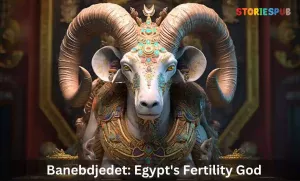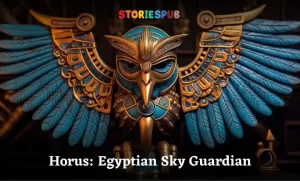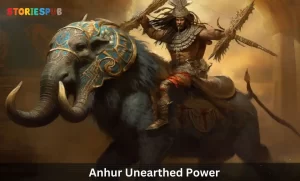Set’s Storm: Chaos, Desert, and Ancient Egyptian Intrigue

Introduction
The God of Chaos, Storms, and the Desert
In ancient mythology, Set was the god of chaos, storms, and the desert. He was a powerful deity who was both feared and revered by mortals and other gods alike. Also known as Seth or Sutekh, he was mentioned in many myths throughout Egyptian history.
Set’s physical appearance is said to have been that of a man with an animal head resembling that of a donkey or jackal. His ferocious nature made him one of the most formidable deities in Egyptian mythology.
Importance of Set in Ancient Mythology
Set played an important role in ancient Egyptian mythology as he represented many different aspects of their lives. He was associated with storms, droughts, and natural disasters that could bring chaos and destruction to their world. His influence on weather patterns made him a powerful figure among farmers who depended on rainfall for their crops.
In addition to his association with the weather and natural disasters, Set was also seen as an important protector against evil forces such as Apophis – a giant snake-like creature believed to threaten the sun god Ra. Furthermore, Set’s reputation grew as he became more prominent in battles between gods where his strength and cunningness were often unmatched.
Setting The Stage For The Story
The tale of Set is one filled with mystery and intrigue. It takes us back to ancient Egypt when myths were used to explain the unexplainable events that happened around them. With his fearsome reputation preceding him everywhere he went, it is no surprise that stories about this god have fascinated people for centuries past his time.
From his rise to power to his eventual fall from grace – there are few deities whose tales are quite as fascinating or wild as that of Set. This article will take you through a complete story of Set, exploring his birth and early life, his rise to power, his influence on mortals, and finally his fall from grace.
We will also examine the lasting impact of this powerful god on ancient mythology and how his mythos continues to influence modern culture. So sit back and prepare to be transported through time as we delve into the story of Set – the god of chaos, storms, and the desert.
Birth and Early Life
The Birth of the god from the Union of Two Powerful Deities
In ancient Egyptian mythology, Set was considered to be the god of chaos, storms, and the desert. According to legend, he was born from the union of two powerful deities: Geb, who represented Earth and Nut, who symbolized the sky. His siblings included Isis, Osiris, and Nephthys.
Set’s birth was not an easy one. The legend states that his mother Nut had been cursed by Re to never give birth on any day of the year.
However, she found a way around this curse with the help of Thoth. Thoth gambled against Khonsu for additional light time for Nut to give birth by using moonlight instead of sunlight as part of his trickery.
Thus, Set was born in a manner that defied both time and space. When he emerged from his mother’s womb fully grown and ready to take on his place as a deity in ancient Egypt.
The Early Life and Upbringing of the god
As a newborn deity without any predestined role or duties in society yet assigned to him, Set had much to learn about how to use his powers responsibly while adjusting himself within an already established pantheon. Set’s upbringing is often debated as some sources suggest that Horus (the son of Osiris) killed Set’s father because he believed him responsible for Osiris’ death. This would make Horus one-half brother only if true.
However, despite these rumors surrounding his origins and childhood; Set quickly established himself as an influential deity within Egyptian mythology due in no part because of his strength and determination. He had quickly become known for being fiercely independent with an inclination towards violence when threatened or challenged.
The Discovery of His Powers and Abilities
From early in his life, Set demonstrated a remarkable level of power and influence in the lives of mortals. His natural ability to control storms and the desert set him apart from other deities, granting him both respect and fear from mortals.
In addition to his control over nature, Set also possessed immense physical strength and agility, making him a formidable opponent in combat. He often engaged in battles with other gods, claiming their powers for himself.
Set’s natural abilities were further enhanced by his use of magical spells and incantations. As he grew older, he discovered new ways to harness his powers and became a master sorcerer.
Overall, Set’s birth and early life were marked by many challenges. However, through determination and the discovery of his unique abilities; he established himself as one of the most powerful deities in ancient Egypt.
Rise to Power
Born into Power
The god of chaos, storms, and the desert was born into a family of powerful deities. His father was the god of creation and his mother was the goddess of fertility.
From a young age, he displayed immense power, with abilities that far surpassed those of his siblings. He quickly became known as a force to be reckoned with in the world of ancient mythology.
Battles with Other Deities
As he grew older, the god began to establish his dominance through battle. He fought fiercely against other gods and mythical creatures in order to assert his place as one of the most powerful deities in existence.
His battles were legendary, with stories told for centuries about how he vanquished even the most fearsome opponents. One particularly famous battle involved the god facing off against a giant serpent that had been causing chaos throughout the land.
The serpent was said to be invincible, but the god managed to defeat it with cunning tactics and sheer brute strength. This victory cemented his reputation as a true warrior and established him as a leader among other gods.
The Rise to Immortality
As he continued on his journey to becoming one of the most powerful deities in ancient mythology, this god began to accumulate followers who worshipped him for his incredible power and influence over their lives. Through their devotion, he gained even more strength until finally achieving immortality – something that few other gods had been able to accomplish.
With immortality came even more power and influence over mortals who looked up to him as an example of strength and perseverance. He became known throughout all corners of ancient mythology as a force not only to be feared but also admired for his ability to overcome any challenge thrown his way.
Establishing Chaos
The god’s rise did not come without consequences, however. As he gained more power and influence, he began to cause chaos throughout the land. His actions were sometimes unpredictable and often caused destruction in their wake.
But for many people, this was just another sign of his incredible power. His chaotic nature became so well-known that it eventually became a defining characteristic of his mythos, with many stories featuring him as a trickster who delighted in causing mischief and chaos wherever he went.
A Force to be Reckoned With
Through his battles with other gods and mythical creatures, his rise to immortality, and the chaos he brought wherever he went, this god became known as one of the most powerful deities in ancient mythology. His influence over mortals was immense, with many seeking to appease him through offerings and sacrifices.
Even today, thousands of years after his first appearance in ancient mythology, the god of chaos, storms, and the desert remains a popular figure whose mythos continues to fascinate people around the world. His journey from a powerful but unknown deity to one of ancient mythology’s most influential figures serves as an inspiration for anyone looking to achieve greatness through sheer force of will.
Influence on Mortals
How mortals viewed and worshipped this powerful deity
The god of chaos, storms, and the desert was a powerful deity in ancient mythology. He was revered by the mortals who believed in him as a force to be reckoned with.
The god had numerous devotees who worshipped him in various ways. Some mortals worshipped him through sacrificial offerings while others offered prayers to appease him.
In ancient times, the priests of this god were held in high esteem by their communities. They were responsible for providing guidance to their followers, interpreting signs from the gods and performing important rituals that would ensure the safety and prosperity of their people.
The impact he had on everyday life, including agriculture, weather patterns, and daily routines
The god’s influence was felt in all aspects of life, including agriculture and weather patterns. The ancient Egyptians believed that he controlled the weather patterns and could bring about both floods and droughts depending on his mood.
They believed that this deity could destroy crops or provide abundant harvests based on how he was appeased. On a daily basis, people would pray to this god for protection from his wrath.
They believed that if they did not show respect towards him or failed to offer suitable sacrifices then they would suffer terrible consequences. In fact, even other gods were said to fear Set’s wrath – an indication of how much power he wielded.
How some mortals sought to appease him while others feared him greatly
While some mortals sought to appease Set through offerings or prayers, others feared him greatly due to his erratic behavior. In fact, many legends depict Set as a fierce warrior who was known for his violent temper – even towards other gods – which made it difficult for some humans or lesser deities to approach him without caution. There were also stories of the god’s sexual conquests and predatory behavior, which created fear and anxiety among his followers.
Nevertheless, he continued to be respected and worshipped, even if it was with some trepidation. The god of chaos, storms, and the desert had a major impact on the lives of ancient people.
His influence was felt in all aspects of life – from weather patterns to daily routines. He was both feared and revered by mortals who believed that his power could bring about either good or bad outcomes depending on how they appeased him.
The Fall from Grace
Set, the god of chaos, storms, and the desert was once a powerful and respected deity among the ancient Egyptians. However, his pride would ultimately lead to his downfall. As he grew more powerful, Set began to believe that he deserved even greater respect and fear from mortals and other gods alike.
His arrogance led him to challenge even the most powerful deities in a bid for ultimate supremacy. He engaged in battles with fellow gods Osiris and Horus, but these conflicts only served to further damage his reputation.
How Pride Led to Downfall for this Once Great Deity
Set’s pride ultimately led him down a dark path. He began to engage in increasingly violent acts of aggression towards both mortals and other gods. His arrogance blinded him to the consequences of his actions, causing him to make many enemies along the way.
Despite warnings from other deities about his destructive behavior, Set refused to change course. His hubris had taken control, leading him down a path towards his own undoing.
The Consequences that Followed
As Set’s power grew increasingly unchecked, it became clear that he needed to be stopped before he caused irreparable damage. The other gods banded together in an effort to bring an end to his reign of terror.
In time, they succeeded in stripping Set of much of his power and casting him out from their society. This was not without significant consequences for both mortals and other deities; crops failed without Set’s intervention in their growth cycles, while storms grew wilder with nobody left to tame them.
How Other Gods Reacted To His Fall
The fall of Set left a significant void within the hierarchy of Egyptian mythology. Some viewed this as an opportunity for personal gain – others as a chance for redemption after years spent living under Set’s tyrannical rule. Many gods were wary of Set even after his fall from grace, however.
They knew that he still possessed a great deal of power and would stop at nothing to reclaim what he felt was rightfully his. While Set’s legacy continued to cast a long shadow over the Egyptian pantheon, his downfall served as a reminder of the dangers of unchecked hubris and the importance of balance in all things.
Legacy
The god of chaos, storms, and the desert had a profound impact on ancient mythology. His story was one that was passed down through generations and it was believed that his powers held sway over all aspects of life. Even though this deity has faded from worship over time, his legacy continues to inspire artists, writers, and filmmakers.
Influence on Art and Literature
The mythos surrounding this powerful deity has inspired countless works of art and literature throughout history. From ancient hieroglyphs to modern-day graphic novels, the god’s story has been told and retold in various forms. Today, he remains a popular subject for paintings and sculptures as artists continue to be fascinated by his complex personality.
Influence on Pop Culture
The god of chaos, storms, and the desert has also had an impact on modern pop culture. His name appears in movies such as The Mummy franchise where he is depicted as a malevolent force seeking to bring about the end of the world. He is also included in many video games where players must battle against him to save humanity.
How his mythos continues
Although this deity is no longer actively worshipped by any major religion today, his mythos still continues to fascinate people across the world. His legacy can be seen in various ways such as:
Modern Occultism
Even though this deity doesn’t hold a place in any major religions today, there are still those who seek knowledge about him through occult practices.
Folklore Practices
In some cultures around the world such as Africa or South America., this deity’s mythology merged with other deities’ mythologies or integrated into folklore traditions.
Conclusion
The god of chaos, storms, and the desert was a powerful deity in ancient mythology that left an indelible mark on human history. Although his worship declined over time, his story continues to inspire and intrigue people today.
His legacy can be seen in various ways such as art, literature, and pop culture. He remains a fascinating figure whose story will continue to be retold for generations to come.
Hey kids, how much did you like Set’s Storm: Chaos, Desert, and Ancient Egyptian Intrigue? Please share your view in the comment box. Also, please share this story with your friends on social media so they can also enjoy it, and for more such Egyptian Mythology, please bookmark storiespub.com.
Related Post :
Set FAQ
What were some of Set's responsibilities and areas of influence?
Set was associated with chaos, storms, and the desert. He was also believed to have the power to protect against evil forces.
How was Set worshiped in ancient Egypt?
Set was not as widely worshiped as some of the other gods and goddesses in ancient Egypt. Some believed him to be a negative force and feared invoking his wrath.
How did Set's image and symbolism evolve over time?
Set's image and symbolism evolved from that of a local desert god to a powerful deity associated with chaos and storms. His image and symbols were often used in architecture, art, and jewelry.
What is the connection between Set and violence?
Set was often associated with violence and was believed to be responsible for acts of chaos and destruction. In some myths, he is depicted as killing his brother Osiris.
How was Set related to other Egyptian gods and goddesses?
Set was often linked with other gods and goddesses, such as Ra, the sun god, and Horus, the god of the sky. He was also associated with the goddess Nephthys, who was believed to have mourning and protection powers.
What were some of the symbols associated with Set?
Symbols associated with Set include the was scepter, a symbol of power, and the ankh, an ancient Egyptian symbol of life.
What is the significance of Set's role in ancient Egyptian mythology?
Set's role in ancient Egyptian mythology highlights the importance of chaos and balance in ancient Egyptian culture. His association with storms and protection also speaks to the importance of these qualities in ancient Egyptian society.
How has Set's image and influence endured over time?
Set's image and influence have endured through the centuries, making him one of the most recognizable and enduring figures in ancient Egyptian mythology. Today, his legacy lives on in modern culture, art, and literature.
What is the significance of Set's role as a protector?
Set's role as a protector highlights the importance of protection and security in ancient Egyptian culture. As a god associated with storms and chaos, he was also believed to protect against evil forces. Set's legacy as a protector continues to be celebrated and revered in modern times.



